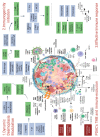Combination, Modulation and Interplay of Modern Radiotherapy with the Tumor Microenvironment and Targeted Therapies in Pancreatic Cancer: Which Candidates to Boost Radiotherapy?
- PMID: 36765726
- PMCID: PMC9913158
- DOI: 10.3390/cancers15030768
Combination, Modulation and Interplay of Modern Radiotherapy with the Tumor Microenvironment and Targeted Therapies in Pancreatic Cancer: Which Candidates to Boost Radiotherapy?
Abstract
Pancreatic ductal adenocarcinoma cancer (PDAC) is a highly diverse disease with low tumor immunogenicity. PDAC is also one of the deadliest solid tumor and will remain a common cause of cancer death in the future. Treatment options are limited, and tumors frequently develop resistance to current treatment modalities. Since PDAC patients do not respond well to immune checkpoint inhibitors (ICIs), novel methods for overcoming resistance are being explored. Compared to other solid tumors, the PDAC's tumor microenvironment (TME) is unique and complex and prevents systemic agents from effectively penetrating and killing tumor cells. Radiotherapy (RT) has the potential to modulate the TME (e.g., by exposing tumor-specific antigens, recruiting, and infiltrating immune cells) and, therefore, enhance the effectiveness of targeted systemic therapies. Interestingly, combining ICI with RT and/or chemotherapy has yielded promising preclinical results which were not successful when translated into clinical trials. In this context, current standards of care need to be challenged and transformed with modern treatment techniques and novel therapeutic combinations. One way to reconcile these findings is to abandon the concept that the TME is a well-compartmented population with spatial, temporal, physical, and chemical elements acting independently. This review will focus on the most interesting advancements of RT and describe the main components of the TME and their known modulation after RT in PDAC. Furthermore, we will provide a summary of current clinical data for combinations of RT/targeted therapy (tRT) and give an overview of the most promising future directions.
Keywords: immune checkpoint inhibition; immunotherapy; pancreatic cancer; radiotherapy; targeted therapy; tumor microenvironment.
Conflict of interest statement
The authors declare that the research was conducted in the absence of any commercial or financial relationships that could be construed as potential conflicts of interest.
Figures


References
-
- Tempero M.A., Malafa M.P., Al-Hawary M. NCCN Guidelines. 1st ed. 2022. [(accessed on 20 July 2022)]. Pancreatic Adenocarcinoma. Available online: http://www.nccn.org/professionals/physician_gls/pdf/pancreatic.pdf.
Publication types
Grants and funding
LinkOut - more resources
Full Text Sources

